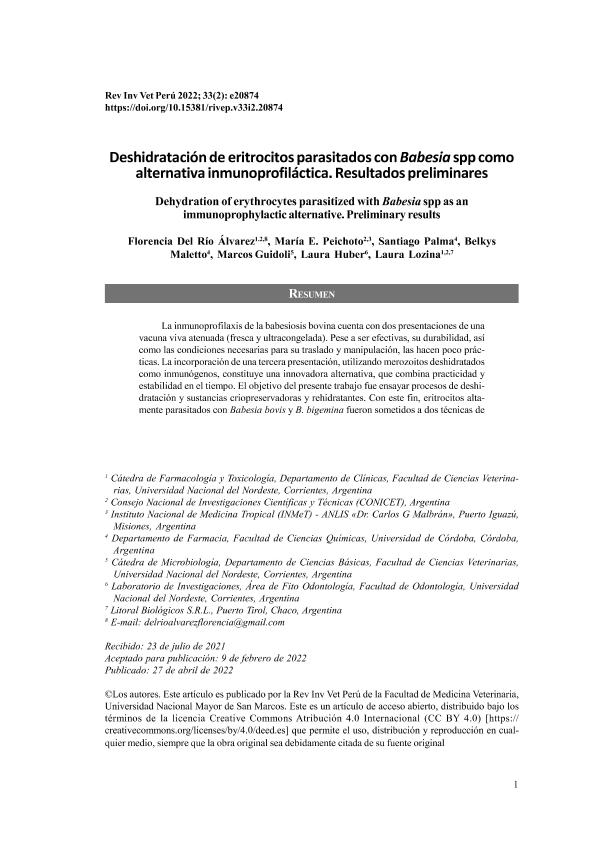Mostrar el registro sencillo del ítem
dc.contributor.author
del Río Alvarez, Florencia

dc.contributor.author
Peichoto, María Elisa

dc.contributor.author
Palma, Santiago Daniel

dc.contributor.author
Maletto, Belkys Angélica

dc.contributor.author
Guidoli, Marcos Gabriel

dc.contributor.author
Huber, Laura Beatriz

dc.contributor.author
Lozina, Laura Analí
dc.date.available
2023-08-04T15:08:31Z
dc.date.issued
2022-04
dc.identifier.citation
del Río Alvarez, Florencia; Peichoto, María Elisa; Palma, Santiago Daniel; Maletto, Belkys Angélica; Guidoli, Marcos Gabriel; et al.; Deshidratación de eritrocitos parasitados con Babesia spp como alternativa inmunoprofiláctica. Resultados preliminares; Universidad Nacional Mayor de San Marcos; Revista de Investigaciones Veterinarias del Peru; 33; 2; 4-2022; 1-11
dc.identifier.issn
1682-3419
dc.identifier.uri
http://hdl.handle.net/11336/206985
dc.description.abstract
Immunoprophylaxis for bovine babesiosis has two presentations of a live attenuated vaccine (fresh and deep-frozen). Despite being effective, their durability, as well as the conditions necessary for their transfer and handling, make them impractical. The incorporation of a third presentation, using dehydrated merozoites as immunogens, constitutes an innovative alternative, which combines practicality and stability over time. The objective of this work was to test dehydration processes and cryopreservative and rehydrating substances. For this, erythrocytes highly parasitized with Babesia bovis and B. bigemina were subjected to two dehydration techniques: lyophilization and spray drying. In turn, for the lyophilization process, several lyoprotectants were tested: Dimethylsulfoxide, Glycerol, Dextrose and Polyvinylpyrrolidone (PVP). The only one that achieved a properly dehydrated powder, crystalline in appearance and brittle to the touch was the PVP. Subsequently, the erythrocytes obtained by both techniques were reconstituted with sucrose solutions (0.25, 0.5, 1 M), 0.9% saline solution, Vega y Martínez solution, phosphate buffer and distilled water. Optical microscopy with an immersion objective showed that the best reconstituent for both lyophilized and spray-dried red blood cells was the 0.25 M sucrose solution, showing a high number of lyophilized and reconstituted red blood cells with preserved morphology. Extrapolating these results to the haemoparasites under study, their application as immunogens would be promising.
dc.description.abstract
Immunoprophylaxis for bovine babesiosis has two presentations of a live attenuated vaccine (fresh and deep-frozen). Despite being effective, their durability, as well as the conditions necessary for their transfer and handling, make them impractical. The incorporation of a third presentation, using dehydrated merozoites as immunogens, constitutes an innovative alternative, which combines practicality and stability over time. The objective of this work was to test dehydration processes and cryopreservative and rehydrating substances. For this, erythrocytes highly parasitized with Babesia bovis and B. bigemina were subjected to two dehydration techniques: lyophilization and spray drying. In turn, for the lyophilization process, several lyoprotectants were tested: Dimethylsulfoxide, Glycerol, Dextrose and Polyvinylpyrrolidone (PVP). The only one that achieved a properly dehydrated powder, crystalline in appearance and brittle to the touch was the PVP. Subsequently, the erythrocytes obtained by both techniques were reconstituted with sucrose solutions (0.25, 0.5, 1 M), 0.9% saline solution, Vega y Martínez solution, phosphate buffer and distilled water. Optical microscopy with an immersion objective showed that the best reconstituent for both lyophilized and spray-dried red blood cells was the 0.25 M sucrose solution, showing a high number of lyophilized and reconstituted red blood cells with preserved morphology. Extrapolating these results to the haemoparasites under study, their application as immunogens would be promising.
dc.format
application/pdf
dc.language.iso
spa
dc.publisher
Universidad Nacional Mayor de San Marcos
dc.rights
info:eu-repo/semantics/openAccess
dc.rights.uri
https://creativecommons.org/licenses/by-nc-sa/2.5/ar/
dc.subject
BABESIOSIS
dc.subject
ERYTHROCYTES
dc.subject
FREEZE-DRYING
dc.subject
IMMUNOPROPHYLAXIS
dc.subject
SPRAY-DRYING
dc.subject.classification
Otras Ciencias Veterinarias

dc.subject.classification
Ciencias Veterinarias

dc.subject.classification
CIENCIAS AGRÍCOLAS

dc.title
Deshidratación de eritrocitos parasitados con Babesia spp como alternativa inmunoprofiláctica. Resultados preliminares
dc.title
Dehydration of erythrocytes parasitized with Babesia spp as an immunoprophylactic alternative. Preliminary results
dc.type
info:eu-repo/semantics/article
dc.type
info:ar-repo/semantics/artículo
dc.type
info:eu-repo/semantics/publishedVersion
dc.date.updated
2023-07-07T21:35:42Z
dc.identifier.eissn
1609-9117
dc.journal.volume
33
dc.journal.number
2
dc.journal.pagination
1-11
dc.journal.pais
Perú

dc.description.fil
Fil: del Río Alvarez, Florencia. Universidad Nacional del Nordeste. Facultad de Ciencias Veterinarias. Cátedra de Farmacología y Toxicología; Argentina. Consejo Nacional de Investigaciones Científicas y Técnicas; Argentina
dc.description.fil
Fil: Peichoto, María Elisa. Dirección Nacional de Instituto de Investigación. Administración Nacional de Laboratorio e Instituto de Salud "Dr. C. G. Malbrán"; Argentina. Consejo Nacional de Investigaciones Científicas y Técnicas; Argentina
dc.description.fil
Fil: Palma, Santiago Daniel. Consejo Nacional de Investigaciones Científicas y Técnicas. Centro Científico Tecnológico Conicet - Córdoba. Unidad de Investigación y Desarrollo en Tecnología Farmacéutica. Universidad Nacional de Córdoba. Facultad de Ciencias Químicas. Unidad de Investigación y Desarrollo en Tecnología Farmacéutica; Argentina
dc.description.fil
Fil: Maletto, Belkys Angélica. Consejo Nacional de Investigaciones Científicas y Técnicas. Centro Científico Tecnológico Conicet - Córdoba. Unidad de Investigación y Desarrollo en Tecnología Farmacéutica. Universidad Nacional de Córdoba. Facultad de Ciencias Químicas. Unidad de Investigación y Desarrollo en Tecnología Farmacéutica; Argentina
dc.description.fil
Fil: Guidoli, Marcos Gabriel. Universidad Nacional del Nordeste; Argentina. Universidad Nacional del Nordeste. Facultad de Ciencias Veterinarias. Instituto de Ictiología del Nordeste; Argentina. Consejo Nacional de Investigaciones Científicas y Técnicas; Argentina
dc.description.fil
Fil: Huber, Laura Beatriz. Universidad Nacional del Nordeste. Facultad de Odontología; Argentina
dc.description.fil
Fil: Lozina, Laura Analí. Consejo Nacional de Investigaciones Científicas y Técnicas; Argentina. Litoral Biológicos S.r.l.; Argentina. Universidad Nacional del Nordeste. Facultad de Ciencias Veterinarias. Departamento de Clínica. Cátedra de Farmacología; Argentina
dc.journal.title
Revista de Investigaciones Veterinarias del Peru
dc.relation.alternativeid
info:eu-repo/semantics/altIdentifier/doi/http://dx.doi.org/10.15381/rivep.v33i2.20874
dc.relation.alternativeid
info:eu-repo/semantics/altIdentifier/url/https://revistasinvestigacion.unmsm.edu.pe/index.php/veterinaria/article/view/20874
Archivos asociados
